by Du Yan-Jhih, project student
Lotus Pond
Did you know? Lotus Pond was originally called "Lotus Flower Pond." It’s located on the eastern side of Zuoying District in Kaohsiung, nestled between the main north-south railway line and the Gaoping River. The pond spans a large area of about 42 hectares and is surrounded by Guishan (Turtle Mountain) and Banpingshan (Half-Screen Mountain), creating a unique and picturesque landscape. Back in the Qing Dynasty, the area was renowned for the lotus and water lilies blooming in summer, earning it the name "Fragrant Waters of the Lotus." The floral scent would waft across the surroundings, making it one of the "Eight Sights of Fengshan." Especially at dusk, the lake reflects Banpingshan and the Dragon and Tiger Pagodas in the sunset, creating a tranquil atmosphere.
If you visit Lotus Pond, you can take a walk along its western shore, where landmarks like Ciji Temple, the Dragon and Tiger Pagodas, Spring and Autumn Pavilions, Qiming Hall, and Yuan Di Temple are all located. The area also features well-designed lakeside roads and bike paths. Along the way, you can enjoy views of ancient temples and lush greenery, making it a great spot for walking or cycling.
Every year in mid-October, Lotus Pond hosts its annual "Wannian Festival." One of the event's highlights is the "Fire Lion Welcoming" blessing ceremony at Ciji Temple. In addition to the festivities, there are plenty of local snacks available, offering a chance to experience Zuoying’s local culture.
Ciji Temple
Did you know? Locals affectionately call this temple the "Old Ancestral Temple." It is located by the Lotus Pond in Zuoying District, Kaohsiung City, and was built before 1719, making it over 300 years old! The temple is dedicated to Poh Seng Tai Tay, one of the key guardian deities for early Taiwanese settlers who crossed the sea to Taiwan. Back then, pioneers brought this deity from their hometown as a family god to pray for safety. Over time, the family deity evolved into a shared belief within the community.
In folk religion, Poh Seng Tai Tay is like an ancient version of a "family doctor." At Ciji Temple, you can always see devout worshippers praying for their family's health and well-being. Not only that, in addition to the help of modern medicine, Poh Seng Tai Tay provides people with spiritual comfort, helping patients face their illnesses bravely and even becoming a protector for doctors. The next time you visit Zuoying, make sure to stop by the Old Ancestral Temple and feel the power of this enduring faith!
Worshippers pray to Poh Seng Tai Tay to express their wishes, and there are many different ways to do so!
The incense sticks is the most common way of prayer, because the rising smoke symbolizes sending wishes up to the heavens! People hold incense sticks and worship sincerely, expressing their wishes to Poh Seng Tai Tay and seeking the deity's protection and guidance. In temples, you often see worshippers burning incense and then placing the sticks into the incense burner, signifying that their wishes have successfully been conveyed to the deity. Each stick of incense represents the worshippers' heartfelt sincerity and prayers!
The moon blocks, or "Jiao Bei," are an important tool in folk religion and Taoism for seeking guidance from the gods. Many people are likely familiar with this ritual! The Jiao Bei have two sides: the flat side is called the "yang side" (front), while the rounded side is referred to as the "yin side" (back). By interpreting the combination of how the blocks land, one can decipher the instructions or messages from the gods!
Divine answer: One upright and one reversed, representing the divine's agreement, approval, or acknowledgment of the requested matter. In simple terms, it means "Okay, this is fine!"
No answer: Both are reversed, indicating that the divine does not approve or grant permission, perhaps the timing is not right yet.
Laughing answer: Both are upright, and this is interesting! It means the divine smiles but does not answer. Perhaps your question wasn't clear enough, or the matter is already predestined, so there's no need to ask further.
Jiao Bei are a special way of communicating with the divine. Each time you cast the Jiao Bei, it is a way of expressing sincerity to the gods.
The drawing divination sticks is a very common method in folk beliefs for seeking guidance from deities about one’s fortune or future direction. When a devotee draws a divination stick, the stick will have a number written on it. With this number, you can find the corresponding divination poem in the poem cabinet. These divination poems are usually written in the form of seven-character quatrains. They may reference historical figures, folk legends, or classical poetry to convey the deity’s message, such as indications of good or bad fortune, warnings, or future considerations.
However, don’t rush to interpret the divination poem as soon as you draw it! It’s customary to pair this with the use of "Jiao Bei" to confirm with the deity whether the drawn stick is correct, ensuring the guidance aligns with your question.
The drawing divination sticks is not only a traditional cultural practice but also an important bridge for communicating with the divine!
The medicine divination sticks are prescriptions believed to diagnose illnesses and provide treatments through the power of deities. The process is quite unique and sacred! Here’s how it works:
First Step: Light three incense sticks and sincerely report your symptoms to the Poh Seng Tai Tay. Make sure to describe them clearly!
Second Step: Gently place the three incense sticks on your wrist, symbolizing the deity “taking your pulse.” Isn’t that profound?
Third Step: Once the ashes from each incense stick fall once, go to the divination stick container for the corresponding medical department and draw a stick.
Fourth Step: After drawing the stick, place the divination poem on the table and use “Jiao Bei” (筊杯) to confirm the guidance. If you receive a sacred sign (聖筊), you can proceed to the cabinet to collect your medicine stick!
Final Step: Follow the instructions on the medicine stick to prepare the corresponding traditional Chinese herbal medicine.
Isn’t it both fascinating and culturally meaningful? If you ever have the chance, be sure to experience it for yourself!
Stepping into the Ciji Temple, the wall filled with Guangming Lanterns is truly captivating! These are no ordinary lamps—they are special lanterns in Taoism used for blessings, brimming with good wishes and prayers. Each tier of the lantern structure contains numerous small compartments, housing red light bulbs. On the outside, there are transparent windows with the donor's name and birthdate written or attached, usually in red ink, symbolizing joy and positive energy.
The fee for lighting a Guangming Lantern not only represents the devotee’s heartfelt prayers but also serves as an important source of incense funds for the temple, supporting its operations and development.
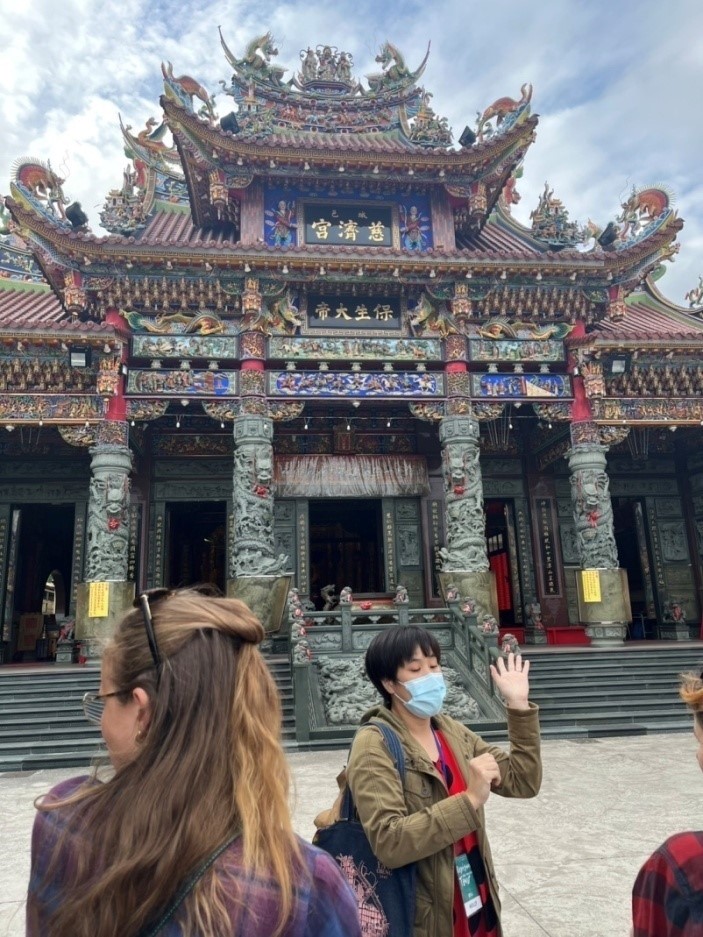
Molly introduced the Ciji Temple.
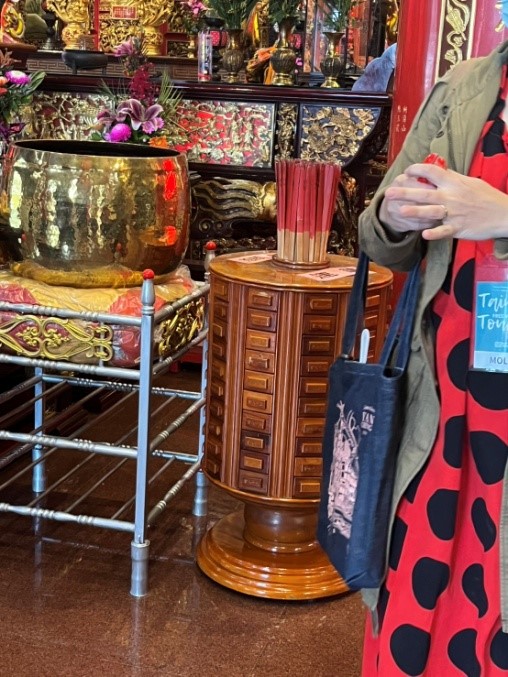
The drawing divination sticks is a method used to seek guidance from deities about future fortunes and misfortunes.
Dragon and Tiger Pagodas
The Dragon and Tiger Pagodas, located on the banks of Lotus Pond in Zuoying District, Kaohsiung City, are one of the most iconic landmarks in the area. Not only do they offer stunning scenery, but they are also rich in historical stories.
In 1974, the Poh Seng Tai Tay of Zuoying's Ciji Temple descended to deliver a prophecy, warning of an impending disaster. To pray for safety, the devotees, following the deity's guidance, began constructing the Dragon and Tiger Pagodas.
Thanks to their collective efforts, the twin pagodas were successfully completed in 1976. According to Chen Ronglong, a standing supervisor of Ciji Temple, the following year, Typhoon Selem indeed struck the area, leading many to marvel at the deity’s accurate prophecy. Additionally, some believe the construction of the pagodas was meant to counteract the negative impact on local feng shui caused by the nearby Yongqing Pagoda.
The Dragon and Tiger Pagodas stand seven stories tall and are full of thoughtful design. Visitors must follow the custom of entering through the dragon’s mouth and exiting through the tiger’s mouth, symbolizing "entering the dragon's throat and exiting the tiger's mouth" to bring good fortune and avoid bad luck. Inside the pagodas, you can admire intricate ceramic murals that tell moral tales, crafted by renowned artisans with exceptional attention to detail. The pagodas, along with the Nine-Bend Bridge, are reflected beautifully on the surface of Lotus Pond, creating a picturesque scene.
Climbing to the top of the pagodas offers a breathtaking panoramic view of the enchanting Lotus Pond landscape.
When visiting Lotus Pond, the Dragon and Tiger Pagodas are an unmissable highlight! They not only immerse you in a rich cultural atmosphere but also provide the opportunity to admire Kaohsiung’s stunning natural beauty.
At the entrance of the Dragon and Tiger Pagodas stands a mystical creature with the body of a turtle and the head of a dragon, known as the Dragon Turtle or "Bixi". This famous feng shui artifact, carved from green stone, exudes an aura of grandeur and majesty as it faces directly toward the entrance of the pagodas.
The Dragon Turtle is one of the nine sons of the dragon in Chinese mythology. Renowned for its strength and ability to bear heavy loads, it is often used as the base of stone steles, symbolizing stability and longevity. In feng shui, the Dragon Turtle is believed to ward off negative energy and attract wealth. Its back is adorned with round coins and ingots, which visually represent its role in drawing prosperity. Placing the Dragon Turtle in front of the Dragon and Tiger Pagodas also carries the auspicious pun of "Róng Guī", meaning "glorious return."
Legend has it that the Dragon Turtle can dissolve harmful energies, such as those associated with Tai Sui (the Grand Duke Jupiter) or other annual conflicts, while also enhancing social connections, attracting benefactors, and bringing good fortune and wealth.
In folklore, touching the dragon’s head or the turtle’s shell is said to bring blessings and good luck. Next time you visit the Dragon and Tiger Pagodas, don’t forget to approach this mystical guardian, feel its protective energy, and make a wish for luck and peace in your life!
Chi Ming Palace
Chi Ming Palace, also known as the Martial Temple, is a shrine that embodies the spirit of the unity of Confucianism, Taoism, and Buddhism. This temple honors the sages of the three teachings, with its main deities being Wen Sheng Confucius and Wu Sheng Guan Gong, accompanied by Yue Fei and Zheng Chenggong. This unique combination carries profound cultural significance, doesn’t it?
Founded in 1899 (the 25th year of the Guangxu Emperor’s reign), Chi Ming Palace is located on the southwestern side of Lotus Pond. Its exterior adopts the architectural style of an Eastern palace, majestic and grand, with every detail steeped in historical charm. During the birthdays of its deities, the hall becomes the lively focal point of celebrations, with devotees performing rituals, welcoming the gods, and offering solemn worship. These ceremonies are not only important religious events but also showcase the rich heritage of local folk traditions.
When visiting Lotus Pond, don’t forget to stop by Chi Ming Palace. You’ll not only experience its solemn atmosphere but also gain a deeper appreciation for the region’s unique cultural and traditional heritage.
Upon reaching the second floor, don't miss out on its unique space! The second floor houses the "Chinese Cultural Relics and Folk Museum," where you can instantly travel through time and experience the charm of traditional culture. In addition, there is a community reading center, providing a comfortable study environment for local students. It also offers a variety of books and magazines, filling the space with a strong cultural atmosphere.
If you want to relax for a moment, the courtyard's fish pond outside is a perfect spot. Watching the fish swim gracefully in the water offers a calming experience, making you feel both mentally and physically rejuvenated!
The fourth floor is a particularly significant place! This is the Lingxiao Hall, dedicated to the Jade Emperor and several other deities, exuding a solemn and sacred atmosphere. Upon entering, you can immediately feel the divine presence and the power of the gods' protection.
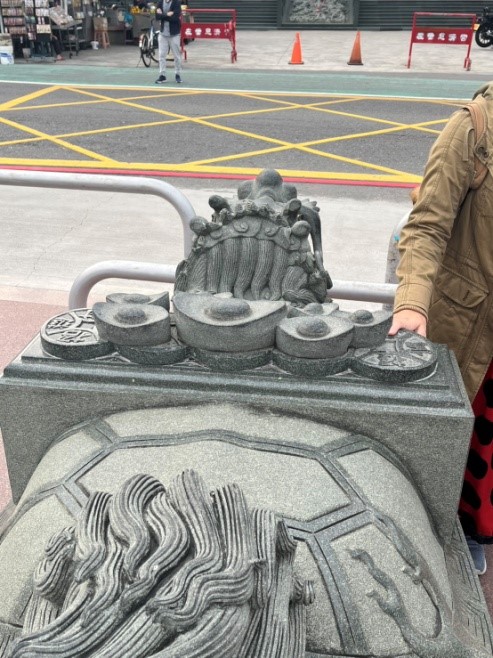
The image displays the treasure on its back. According to legend, touching these treasures can bring good fortune and wealth.
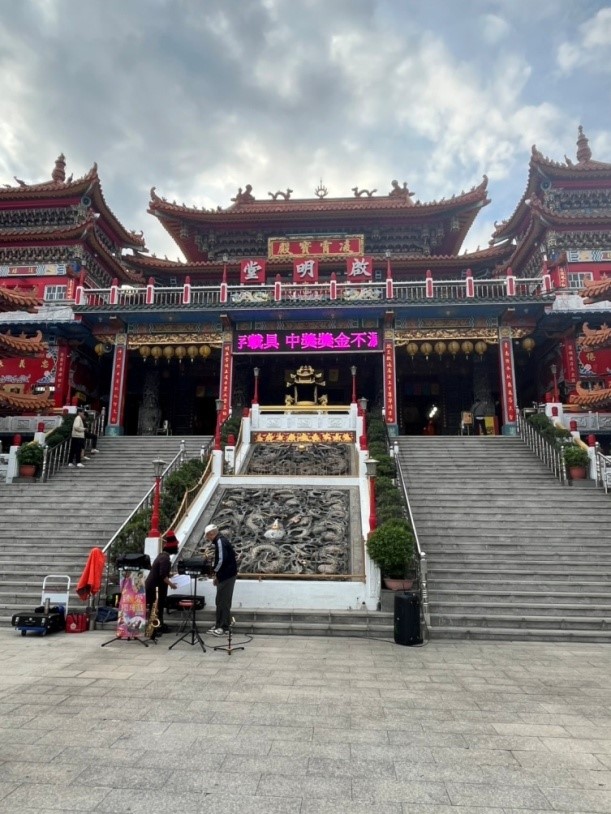
Located beside Lotus Pond in Zuoying, Chi Ming Palace.
Spring and Autumn Pavillions
The Spring and Autumn Pavilions by Lotus Pond are truly a classic spot! Built back in 1953, they are now over 60 years old. The site features two pavilions, one named "Spring Pavilion" and the other "Autumn Pavilion," as a tribute to Confucius' Spring and Autumn Annals. These pavilions have a unique architectural design, with four-story octagonal shapes, green-tiled roofs, and yellow walls. Their reflection on the water, along with the connecting zigzag bridge, creates a charming, nostalgic scene.
The pavilions were built to honor Guan Yu, and some also call them the "Imperial Pavilions of Spring and Autumn." Inside, there’s a dragon-shaped tunnel, where visitors can enter through the dragon's mouth. The walls are adorned with vibrant, detailed paintings depicting various religious stories, offering plenty to admire as you walk through.
In addition, in front of the Spring and Autumn Pavilions stands a statue of Guanyin riding a dragon. According to legend, this statue was modeled after an appearance of the Bodhisattva riding a dragon. It’s said that Guanyin specifically instructed devotees to build it here. Now, the statue stands between the two pavilions, adding an air of mystique and storytelling to the site.
Yuan Di Temple
The Yuan Di Temple in Zuoying has been a major center of faith in the area since its early days. It all began in 1666, during the 20th year of the Yongli reign in the Ming Zheng period, when a simple straw hut was built to honor the guardian deity, Mazu, also known as Linshui Furen. It’s said that she was the first deity to arrive in Zuoying. Later, the Earth God and Zhu Fu Qiansui joined the “team.” Since Zhu Fu Qiansui held a higher status, he eventually became the temple’s primary deity. By 1714, construction on a more formal temple began, and three years later, it was completed, finally giving the community a proper place of worship.
Then came the legend! During the Qianlong and Jiaqing reigns, a fisherman in Wandan Port accidentally caught a statue of Xuantian Shangdi while fishing. From that point on, his fishing ventures were smooth and successful, with bountiful catches becoming the norm. Word of this spread quickly, and Xuantian Shangdi’s reputation grew. The locals decided to enshrine Him as the temple’s primary deity, renaming the temple “Beiji Dadi Temple.”
Over the years, Yuan Di Temple underwent several renovations. The most significant reconstruction took place in 1972, as the community’s improved living conditions allowed them to rebuild the temple into its current form. Today, the temple is more than just a place of worship; it’s a treasure trove of stories. Every corner seems to quietly tell tales of life in Zuoying’s past, brimming with a rich sense of history.
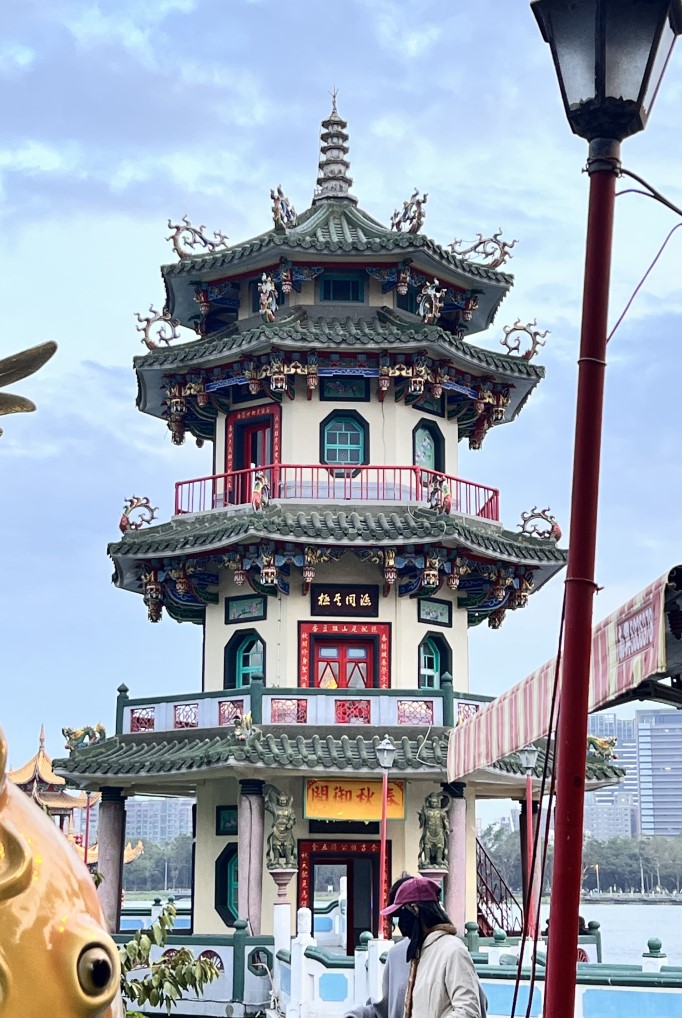
The image shows the Imperial Pavilions of Spring and Autumn.
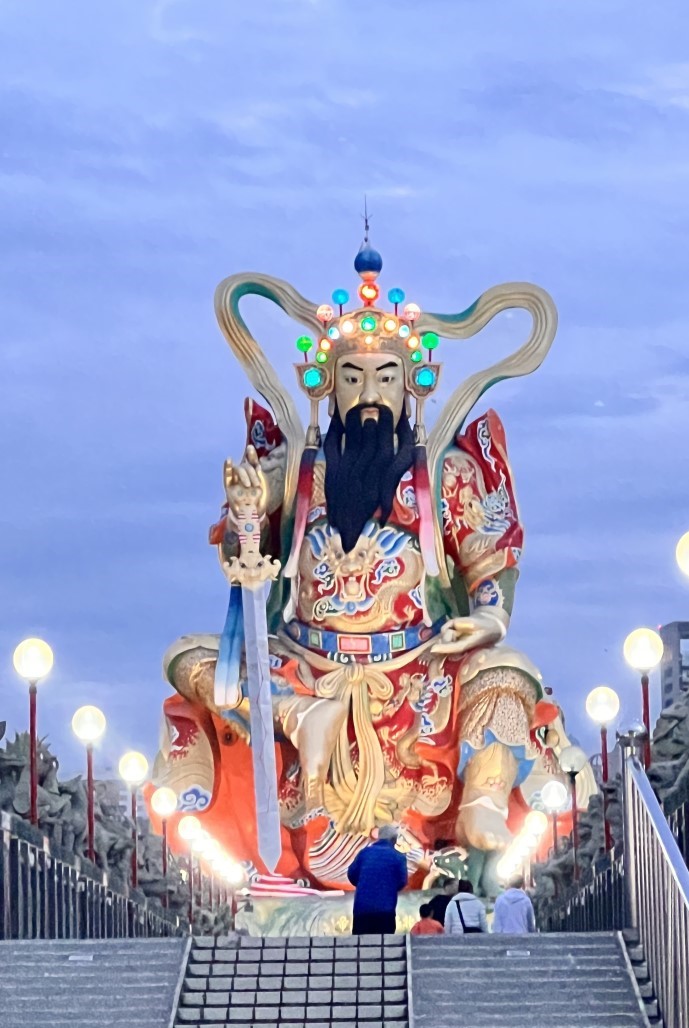
The Statue of Xuantian Shangdi of the North Pole.
